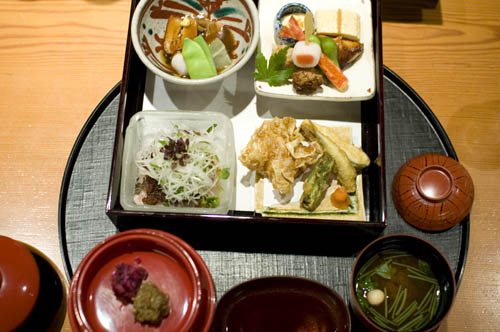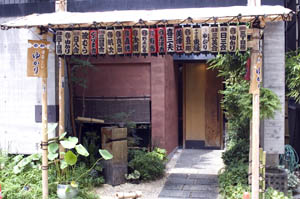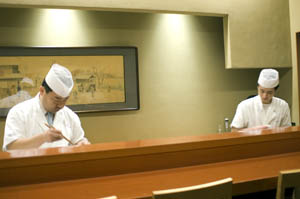Nihonbashi Yukari serves magnificent seasonal Japanese cuisine in a casual, relaxed settting. And while dinner might set you back Y10-20,000 with drinks, lunch is an amazing bargain. Regular lunches start at just Y2100, and the sumptuous deluxe bento lunch is Y3675 - excellent value for this level of cooking.
If it's your first lunchtime visit you might want to spring for the deluxe bento, which you should order in advance when you make your reservation. During a mid-summer visit our meal started with chawan-mushi (savory egg custard) livened up by a salty ume plum and chunks of sweet, tender grilled anago eel - a nice warm-weather appetite-starter.
The main event was a serving tray showcasing four different preparation styles - raw (kampachi and katsuo sashimi with finely chopped scallions in a refreshing ponzu dressing); deep-fried (several beautifully done tempura items including pleasantly crunchy yuba skin); braised (featuring some of the best pork kakuni stew we've ever tasted); and grilled (the fantastic buri was the standout). The soup was sublime, the pickles outstanding. We finished off with an adventurous soy-milk ice cream with black beans and kinako.
Regular lunches are similarly well prepared but perhaps not quite as elaborate - for example the tempura lunch (Y2100) features a generous serving of assorted seafood and vegetables along with a few tiny side items. The dining areas are modern and tasteful, and service is competent but not fussy - our waitress didn't go out of her way to announce every single ingredient on the plate, but seemed happy to answer questions.
In the evenings things get somewhat fancier - it's modern kaiseki service with lots of creative touches and special deluxe ingredients. Prix-fixe menus are priced Y6,300-15,750, and the drinks menu includes a decent selection of Japanese wines as well as private-label sake, beer and shochu. Third-generation chef Kimio Nonaga trained at the legendary kaiseki restaurant Kikunoi in Kyoto for seven years, and also won an Iron Chef trophy back in 2002.
by Bjorn Katz











